An electrical busbar consists of a metallic conductor in a shape like a bar or a strip enclosed in switch gear, panel boards, and busway enclosures. Electrical power is collected from input feeders and distributed to output feeders by conductors or groups of conductors.
In other words, it is a typed splice that connects all the inbound and outbound electrical currents. In this way, the electric busbar collects electrical energy in place.
The busbar system consists of the isolator and the circuit breaker.
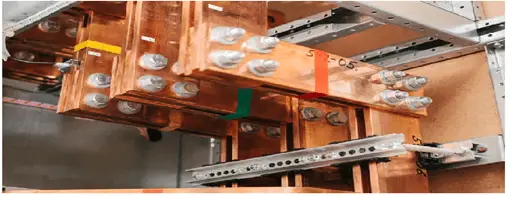
Busbars are available in a variety of shapes and sizes. Rectangular, tubular, round, and many other shapes. A rectangular is mainly used in power systems.
Copper, aluminum, and brass are used for the manufacture of the electrical bus bar.
Importance of Busbar
There are several types of busbar arrangements used in power systems. There are many factors to consider when selecting a busbar, such as reliability, flexibility, and cost. In selecting a particular busbar arrangement, the following factors should be considered.
- The busbar layout is simple and easy to maintain.
- System maintenance did not affect its continuity.
- Busbar installation is economical.
A single busbar is used in the case of small substations, where continuity of supply is not critical. But in the large substations, an additional bus bar is used in the system to avoid interruption in the supply.
Coating on Busbar
The durable protection layer is provided by coating on the busbar surface and will prevent oxidation. Metal and non-metal coatings are applied on busbars. Tin, Nickel, and Silver are used to coat busbars. Busbar is coated for three reasons
- To prevent corrosion
- Improve conductivity
- To enhance the appearance
Shapes of busbars
The different types of electrical busbar arrangements are shown in the figures below.
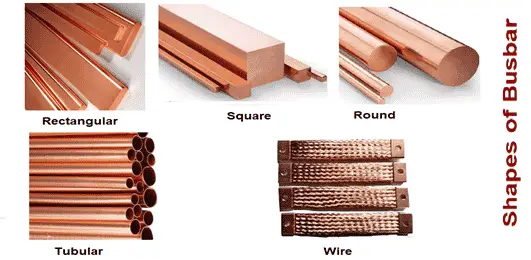
The electrical busbar comes in a variety of shapes, sizes, and materials.
- Rectangular busbars are widely used in industries due to their qualities including assembly operations such as cutting, bending, and joining are easy. It handles high current.
- Square shape busbars are rarely used because of worse ventilation, and assembly is more difficult.
- Tubular shape bus bar is used electrical substations for very high voltages. Tubular-shaped busbars provide good ventilation and mechanical resistance. High cost is the most significant disadvantage. Its installation is complex, and special care is required.
- Wired busbars are flexible and used in the connection of terminals of equipment subjected to vibration, and shocks, such as transformers, induction voltage regulators, circuit breakers, and others.
- Round or circular shape busbar used in limited applications where there is a little current through them and service voltage is low. Examples are the interconnection of instruments on boards and synchronization bars.
Types of busbar
In the power system, the type of busbar system used will depend on the role and importance of the substation. The voltage level, installed capacity, and the expected reliability of network operation are the parameters involved while selecting the busbar.
Single busbar System
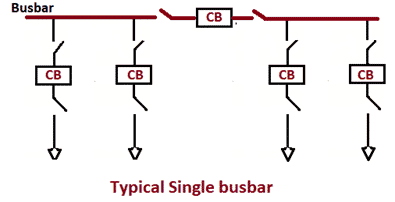
very simple and easy to set up a single busbar type of system. Together with the isolator switch, there is only one busbar in the system. There is only one busbar connecting all substation equipment such as transformers, generators, and feeders.
Advantages
- Initial costs are low.
- Less maintenance is required.
- The operation is simple.
Disadvantages
- The entire supply is disturbed when the fault occurs.
- As the arrangement provides the least flexibility, it is used in small substations where continuity of supply is not crucial.
Single busbar arrangement with sectionalized bar
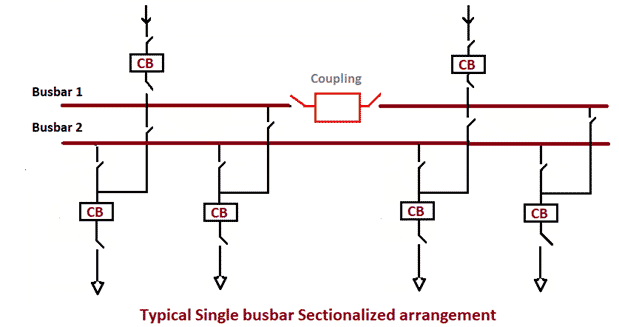
In this type of arrangement, circuit breakers and isolating switches are used. The isolator prevents the entire system from shutdown by disconnecting the faulty section of the busbar. An additional circuit breaker is used in this arrangement, which does not add much to the cost.
Advantages
- The defective section is removed without interfering with the supply continuity.
- It is possible to perform maintenance on individual sections without disrupting the system supply.
- A system with a current-limiting reactor that reduces fault occurrence.
Disadvantages
- Additional circuit breakers and isolators increase the cost of the system.
Double busbar System
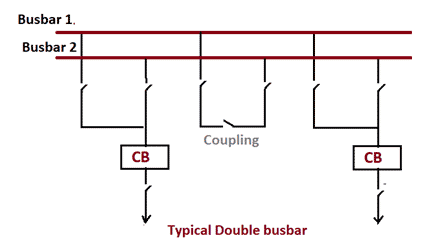
To increase the flexibility of the single bar, a second can be added. Main bar and a switch for coupling the two bars, forming a configuration called a Double busbar.
The configuration is flexible since it allows to separate circuits in each one of the bars, thus being able to divide systems.
Advantages
- It also has reliability but is not safe for failure in bars and switches.
- It is also possible to do maintenance in busbars without suspending the service and for this reason, it is used in areas of high environmental pollution.
- It adapts very well to highly meshed systems in which flexibility is needed.
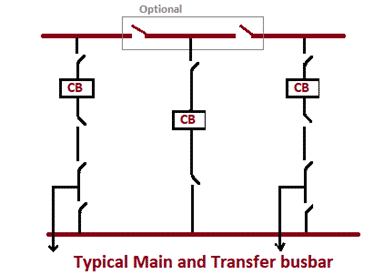
There are two types of busbars used in this type of arrangement, namely the main busbar and the auxiliary busbars. A bus coupler connects the isolating switches and circuit breakers to the busbar arrangement. In case of overload, the bus coupler transfers and connects load from one bus to another.
Advantages
- The continuity of supply remains the same even in failure. When the failure occurs on either bus, the entire load is transferred to the other bus.
- Repair and maintenance can be easily carried out on the bus bar without shutting down.
Ring Busbar
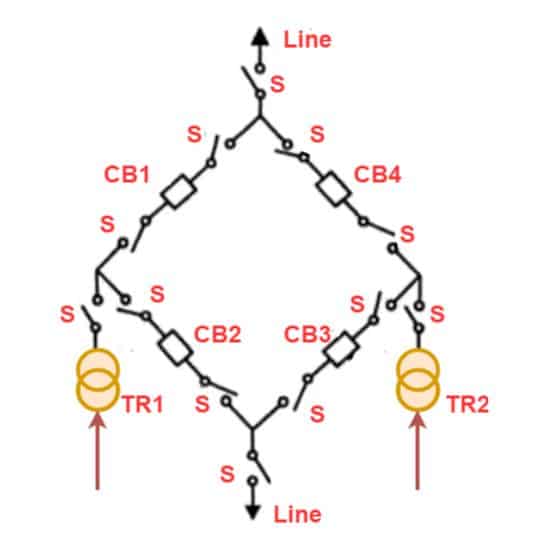
In this type of arrangement, two circuit breakers function on one line. The circuit breakers CB1 & CB2 function on one line, and the circuit breakers CB3 & CB4 function on another line.
Advantages of Ring Bus-bar System
- This ring bus-bar system provides a redundant path to the circuit and any failure in one of the circuits does not interrupt the electrical supply completely.
- It is possible to carry out maintenance of any circuit breaker, without interruption of power.
Disadvantages of Ring Bus-bar System
- Difficult to add new circuits to the system.
So many ways busbar system can be arranged, as per requirement of individual needs.